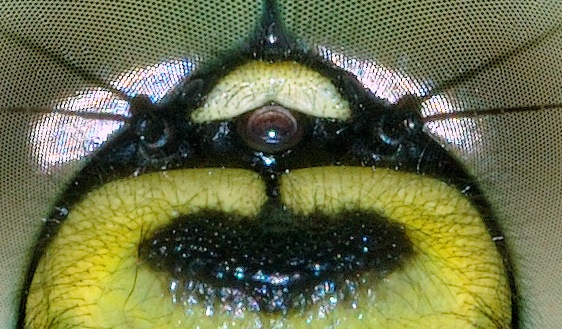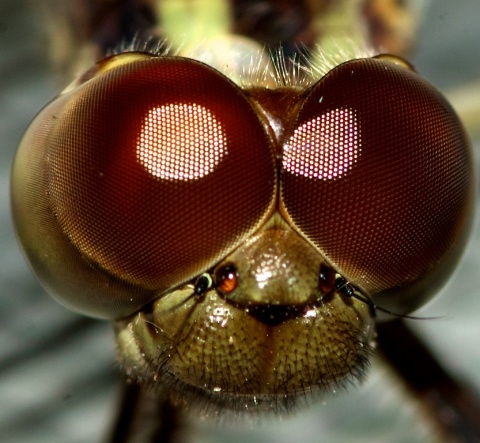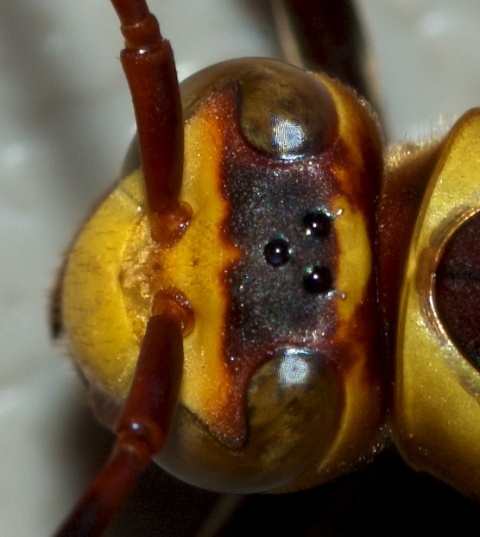The first few days of fall in Florida often bring cold (well, cool) fronts to the region. This year we’re already on our second or third round of long-sleeve days, so I thought this might be a good time to show off what I’ve been able to capture of the cold-slowed insect fauna.
Here’s a photo from last week; it’s the Blue Dasher (Pachydiplax longipennis) with the messed-up wing from the front porch. The Blue Dasher is a member of a monotypic group (which just means that, like Tigger, the wonderful thing about the Blue Dasher is it’s the only one of its kind) in the skimmer family (Libellulidae). Despite its lack of close cousins, it’s one of the most widespread and common dragonflies in North America. Back in 2010, it was the most commonly submitted record at Odonata Central, with 368 records (2.3% of the total). [Note: A search of that site today reveals that there are now 1602 records of this species on the site, but it’s been outstripped in popularity by the previous number 2 species, Eastern Pondhawk (Erythemis simplicicollis), with 1680 records as of today.]
Our next dragonfly shot is from this morning, and it’s another member of the Libellulidae family. I’m not sure of the species, although I suspect a very young female Roseate or Bar-winged Skimmer. In any case, this individual was perched on the screen of the kitchen window in fairly deep shade, which I suspect is why she was so patient with the camera for so long. Of course, the instant I got to the right distance and camera angle after dozens of so-so shots, I had time for only one image before she decided she’d had enough and repaired to a nearby bush to sulk:
But, at least I got the shot.
In both photos, the most prominent feature is, of course, the pair of compound eyes. But if you can tear your eyes away from those multifaceted jewels, you can see plenty of other interesting things. For example, both of these little ladies look like they could use a shave; in these extreme close-ups, the sensory hairs on their frons (the biggest area of the “face”) stand out in, if not razor-sharp relief (technically they’re a bit blurry because the depth of field even at these large ƒ-stops is minuscule), at least somewhat sharp detail.
You can also see the two small antennae. Dragonflies are primarily visual, rather than tactile, creatures, so their antennae are greatly reduced. In fact, the great dragonfly biologist Tillyard (1917), writes of having surgically removed the antennae from dozens of species and finding no observable loss of function in any of them: “In no single instance did the operation affect the insect in the least.” (He also removed the heads of dragonflies and discovered that the bodies live for up to two days longer, “while the wings vibrate vigorously whenever the thorax is touched.”) Later researchers have speculated that the main function of the antennae in odonata is to measure wind speed and perhaps direction.
Situated very near the antennae are two of the three simple eyes, or ocelli. They look like globs of liquid in these photos, but they are actually light-sensitive structures made of chitin (like every other insect structure). There are always three, but in none of my images have I been able to capture all three. Here, in a rotated and isolated detail from a fabulous Wikipedia image, are the three ocelli of Aeshna cyanea. The prominent one is the median ocellus; the other two are much harder to see, but if you look up and to the middle at about 45° from the base of the antennae you should be able to make them out:

According to Tillyard again, the median ocellus used to be a pair of ocelli that have merged. Recall that the purpose of ocelli seems to be to detect light levels, rather than shapes or movement, while the ommatidia (facets) of the compound eye combine to form images of shapes as far away as 2 meters, while they can detect motion up to 20 m (or more) away.
Just as a reminder, the ocelli of other insect species are often relatively easy to make out, provided you’re brave enough to get close enough to make them out:
This Polistes major wasp was involved in a complicated social interaction with another member of its species; it lasted all morning long. I’m still not sure whether there was some sort of dominance being tested, or sibling rivalry being enacted, or what, but these two wasps were very close to each other for a very long time:. More on this in the next post.
References
Paulson, D. 2011. Dragonflies and Damselflies of the East. Princeton: Princeton UP.
Tillyard, R. J. 1917. Biology of Dragonflies. Cambridge: Cambridge UP.



